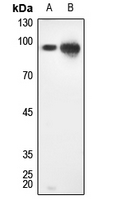Description:Rabbit polyclonal antibody to STAT1Immunogen:KLH-conjugated synthetic peptide encompassing a sequence within the C-term region of human STAT1. The exact sequence is proprietary.Purification:The antibody was purified by immunogen affinity chromatography.Clonality:PolyclonalForm:Liquid in 0.42% Potassium phosphate, 0.87% Sodium chloride, pH 7.3, 30% glycerol, and 0.01% sodium azide.Dilution:WB (1/500 - 1/1000), IH (1/100 - 1/200), IP (1/10 - 1/100)Gene Symbol:STAT1Alternative Names:Signal transducer and activator of transcription 1-alpha/beta; Transcription factor ISGF-3 components p91/p84
Entrez Gene (Human):
6772;
SwissProt (Human):
P42224;
SwissProt (Mouse):
P42225;
Storage/Stability:Shipped at 4°C. Upon delivery aliquot and store at -20°C for one year. Avoid freeze/thaw cycles.
-
 Western blot analysis of STAT1 expression in Hela (A), HGC27 (B) whole cell lysates. (Predicted band size: 87 kD; Observed band size: 91 kD)
Western blot analysis of STAT1 expression in Hela (A), HGC27 (B) whole cell lysates. (Predicted band size: 87 kD; Observed band size: 91 kD) -
 Immunohistochemical analysis of STAT1 staining in human lung cancer formalin fixed paraffin embedded tissue section. The section was pre-treated using heat mediated antigen retrieval with sodium citrate buffer (pH 6.0). The section was then incubated with the antibody at room temperature and detected using an HRP conjugated compact polymer system. DAB was used as the chromogen. The section was then counterstained with haematoxylin and mounted with DPX.
Immunohistochemical analysis of STAT1 staining in human lung cancer formalin fixed paraffin embedded tissue section. The section was pre-treated using heat mediated antigen retrieval with sodium citrate buffer (pH 6.0). The section was then incubated with the antibody at room temperature and detected using an HRP conjugated compact polymer system. DAB was used as the chromogen. The section was then counterstained with haematoxylin and mounted with DPX.
Efficient delivery of RNA Interference to peripheral neurons in vivo using herpes simplex virus
Normal breast tissue implanted into athymic nude mice identifies biomarkers of the effects of human pregnancy levels of estrogen
A fusion of GMCSF and IL-21 initiates hypersignaling through the IL-21Ralpha chain with immune activating and tumoricidal effects in vivo
Roles of vaccinia virus genes E3L and K3L and host genes PKR and RNase L during intratracheal infection of C57BL/6 mice
Transgenic expression of interferon in mouse stomach leads to inflammation, metaplasia, and dysplasia
Hypomethylating therapy in an aggressive stroma-rich model of pancreatic carcinoma
Mouse B2 SINE elements function as IFN-inducible enhancers


 Datasheet
Datasheet MSDS
MSDS